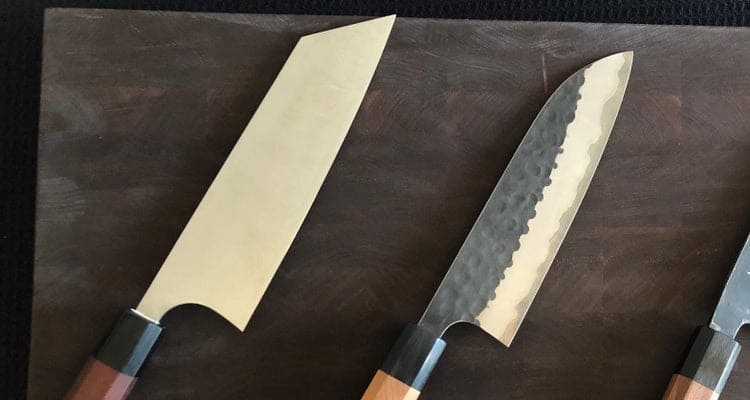
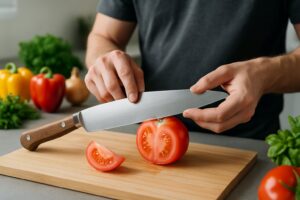

If you love being in the kitchen, picking between a Santoku and a Bunka knife can feel like a big decision. Both are staples in Japanese cooking, but they bring different benefits to the table.
The Bunka tends is a longer blade with a sharp “K-tip” point that is perfect for precision tasks like mincing herbs or making those tiny, careful cuts. The Santoku has a wider blade with a rounded “sheep’s foot” tip. This knife is best for beginners and is great for slicing, dicing, and chopping veggies.
The Bunka is a multipurpose Japanese knife. The full name, Bunka Bōchō, refers to the traditional use of the knife to prepare cultural dishes in Japanese homes. In Japanese ‘Bunka’ means culture while ‘Bōchō’ means kitchen knife.

The Santoku is a popular kitchen knife in the United States. In Japanese Santoku means ‘three uses’ or ‘three virtues’. The meaning represents the three types of cuts the knife is crafted for: dicing, slicing and mincing.
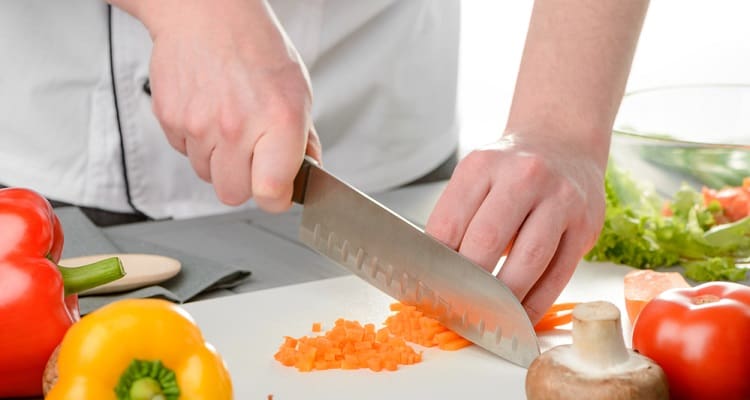
Bunka and Santoku Knives are both designed for tackle kitchen basics such as slicing fruit, dicing veggies, and cutting meat.
The Santoku knife is just made for push cuts. Its blade is mostly flat with a slight curve, so you can chop straight down in a steady, up-and-down rhythm. That makes cutting vegetables a breeze. The Bunka knife has a flatter heel and a sharp K-tip, which adds precision for those times you need more finesse.
For slicing, both knives do the job, but the Bunka’s pointed tip gives you more accuracy. Think tomatoes or onions where you want finely cut slices. When dicing, the Santoku’s wide blade scoops up ingredients easily. For mincing, either knife works, but the Santoku’s tall blade keeps your fingers safer.
| Task | Santoku | Bunka |
|---|---|---|
| Chopping | Excellent | Very good |
| Precision | Good | Excellent (sharp tip) |
| Mincing | Very good | Very good |
| Decorative | Decent | Excellent |
The Bunka comes into its own when you need detail. Its pointed tip is a lifesaver for intricate prep such as trimming fat, removing stems, or making decorative cuts. Sure, it can chop and slice too, but the tip gives it an edge for cooks who care about accuracy and want a knife that can handle both big and small jobs.
The Santoku really excels at everyday food prep slicing veggies, boneless meats, and fish. Its flat blade makes for easy chopping and dicing, and the gentle curve lets you rock the knife if you want.
The Bunka knife’s thinner, sharper tip is a game-changer for trimming fat or slicing thin pieces of fish and meat. You can slip right under silver skin or work around bones with a lot more confidence. If you’re into Sashimi, Carpaccio, or just like your cuts neat, the Bunka delivers.
The Santoku is a workhorse. You can pile up chopped carrots, celery, potatoes, and just keep going. The Bunka can do this too, but its tip comes in handy if you want to shape veggies or get fancy with garnishes.
If you mostly chop big veggies or power through repetitive tasks, go for the Santoku. If you want a knife that’s good for both detail and variety, the Bunka is the better option.
Bunka knives stand out with their “K-tip” or kiritsuke-style tip. The spine drops sharply near the end, creating a strong, pointed tip. That extra pointiness helps with fine cuts such as scoring meat or thinly slicing garlic. The K-tip gives you more control for detailed work than the Santoku’s rounded edge.
The Santoku blade features a “sheep’s foot” profile. Its spine curves down gently toward the edge, ending in a rounded tip. This makes it a favorite for push cuts, veggie slicing, and quick herb chopping. The lack of a sharp point keeps your hand safer during fast dicing.
If you want something that covers both precision and everyday prep, the Bunka’s pointed tip is hard to beat. But if you are all about fast chopping, the Santoku’s rounded tip and straighter edge just feel right. Here’s a blade shape comparison if you want to see the profiles side-by-side.
Bunka knives are thinner along the blade and spine. This thinness lets them glide through soft produce with barely any resistance, which feels pretty satisfying when you’re slicing. Some Bunka knives, especially those called lasers, really double down on thinness for speed and clean cuts.
Santoku knives usually have a thicker spine, which adds some heft and durability. That extra thickness helps when you’re chopping through firm vegetables or boneless meats. The thicker spine makes the knife feel solid in your grip.
It’s worth noting that Bunka knives can be a bit more delicate at the tip. If you misuse them, that sharp point might chip. If you deal with tougher ingredients and want a little extra confidence, the Santoku’s thicker spine is a safer bet.
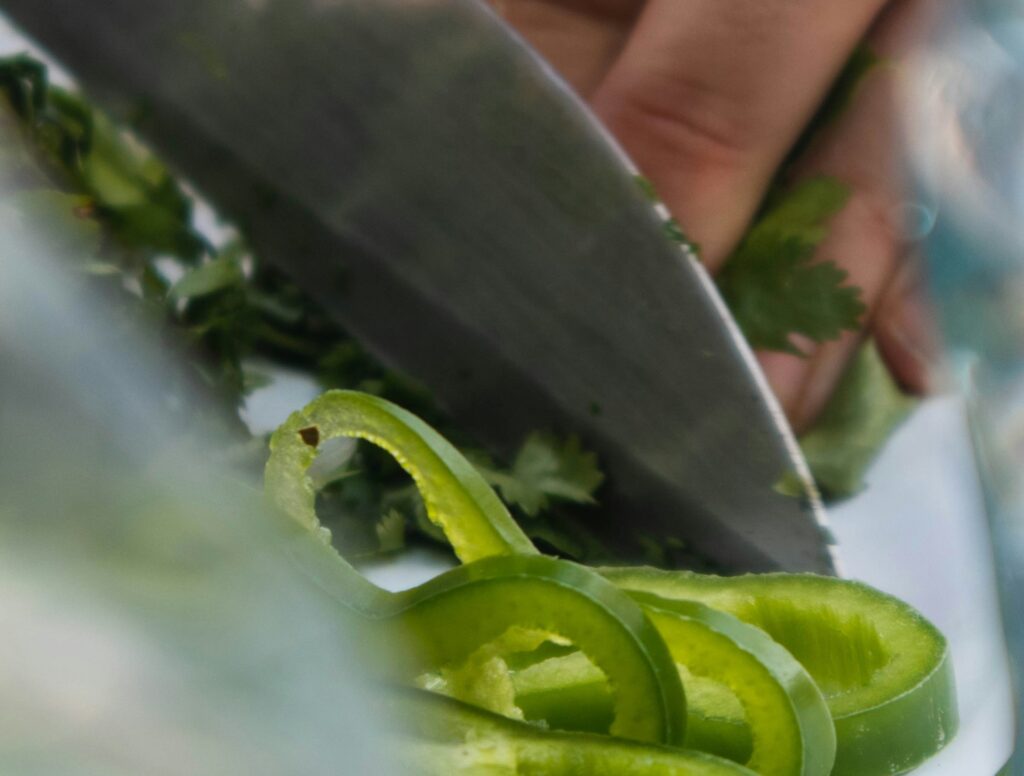
Bunka knives are between 5 and 8 inches in length. The Bunka’s blade height is often less than the Santoku, which can make it feel lighter and more agile for slicing.
Santoku knives typically measure between 4.5 and 7 inches. The blade is usually pretty tall from spine to edge, which gives your knuckles room to clear the cutting board. This is a real plus if you chop quickly.
Both knives have double-edged blades, so they work for left and right handed users.
Santoku and Bunka knives may look similar at a glance, but their blade construction can change how you use and care for them. Paying attention to steel type, blade structure, and sharpening needs makes a difference in your kitchen routine.
Santoku and Bunka knives come in both carbon steel and stainless steel flavors.
Carbon steel blades get super sharp and hold their edge well. They’re easy to sharpen, but if you don’t keep them dry and clean, they’ll rust or stain. Folks who want a razor-sharp edge and don’t mind a little upkeep often go for carbon steel.
Stainless steel blades are way easier to take care of. They’re less likely to rust, though they might not get quite as sharp as carbon steel. Both steel types show up in Santoku and Bunka knives, so it really comes down to how much maintenance you’re willing to do and how sharp you want your knife.
San Mai is a classic Japanese way of sandwiching a hard steel core between two softer steel layers. This method adds toughness and flexibility, which can help prevent chipping.
You’ll see San Mai construction in both Santoku and Bunka knives. The hard core’s toughness gets measured by the Hardness Rockwell Scale of between 58 and 62 HRC. A higher HRC means a harder steel that keeps its edge longer, but it might chip if you’re not careful. Softer steels with a lower HRC are tougher, but you will need to sharpen them more often.
Checking the HRC can help you pick a knife that matches your cutting style—or at least avoid surprises down the road.
Edge retention is basically how long your knife stays sharp while you’re using it. If you go for Santoku or Bunka knives made from hard steels (higher HRC), you’ll probably notice they keep their edge longer—less sharpening, more slicing. The trade-off? Hard steels can be a bit brittle, so you’ll want to avoid hacking through tough stuff or bones.
When it comes to sharpening, carbon steel is a favorite. It responds fast to a whetstone or honing rod, which is great if you like your knives super sharp all the time. Stainless steel takes a little more elbow grease to sharpen, but it’s less fussy if you forget to maintain it now and then.
Pick a knife that matches how much sharpening you’re willing to do and how rough you are in the kitchen.
Japanese kitchen knives, including Bunka and Santoku, usually feature wooden handles. Black pakka wood is popular because it’s tough, smooth, and shrugs off water. Other handles use magnolia, walnut, or even composite wood.
The handle shape? That matters more than you’d think. Traditional Japanese Wa-handles are round or octagonal, giving a light, balanced grip.
Western-style (yo) handles are heavier, sometimes with finger grooves for extra security. You will spot both handle types on Santoku knives, but Bunka knives mostly Wa handles.

Santoku and Bunka knives both shine in the kitchen, but they each have their quirks. Blade shape, tip, and handle all play a part in how they feel and perform for meal prep.
Both are great for slicing, dicing, and mincing. The Santoku’s flat edge makes it a go-to for veggies, meats, and fish. The Bunka’s sharp tip is perfect for detail work—like thinly slicing garlic or herbs.
The Santoku has a rounded, “sheep’s foot” tip—safe, not likely to poke through your food. The Bunka’s K-tip is angular, sharp, and built for precision or piercing. This tip shape gives the Bunka its signature look and extra cutting finesse.
Handles come in both traditional Japanese and Western styles for each knife. Most Bunka and Santoku knives feel light and balanced, which is nice for long sessions. There’s no clear winner here. Try both knives and see what feels right in your hand.
The Bunka’s flat blade and pointy tip make it awesome for push cuts, slicing, and anything that needs a little finesse. Quick, clean chopping? No problem. The tip also handles delicate work with herbs or thin meats.
The Santoku Knife’s wide, flat edge glides through veggies with straight, simple cuts—great for dicing or mincing. It’s not as nimble for detail work. The Bunka, with its sharp tip and flatter profile, can handle both big prep and tiny, precise chopping.
Both knives need regular honing and sharpening to stay sharp, but there are some quirks. The Bunka’s pointed tip feels a bit fragile—if you’re not careful, it’ll chip, so sharpening and handling it gently just makes sense.
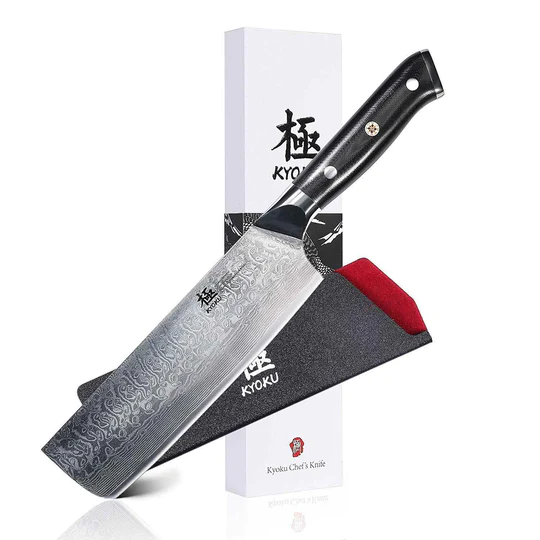
Knife Buzz offers independent product reviews on a wide range of knives used in the kitchen, home, and outdoors. We make it easy for you to find the right knife at the best price.